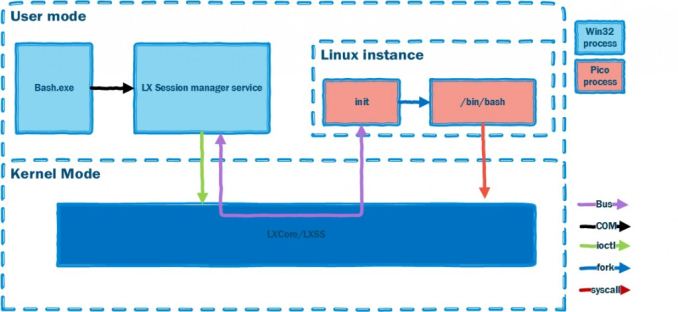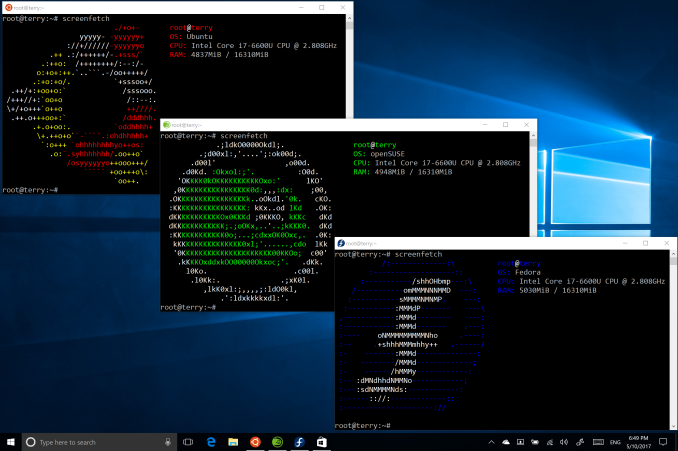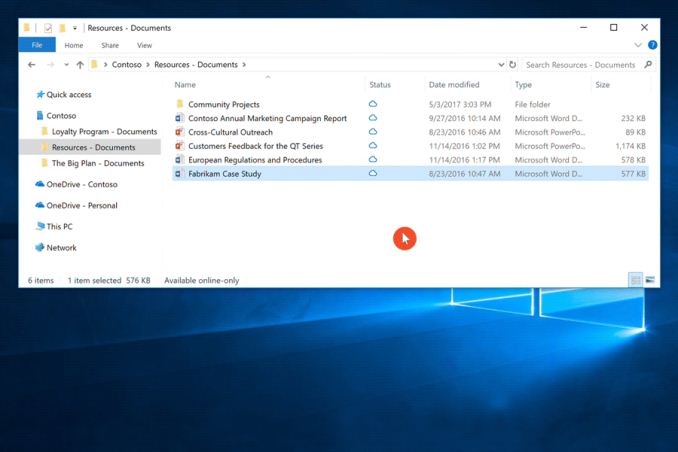The Microsoft Build 2017 Recap: What To Expect When You’re Expecting Windows
by Brett Howse on May 19, 2017 8:00 AM ESTWindows Subsystem for Linux
Microsoft bringing Linux into the Windows platform was one of the most surprising announcements at Build last year, and as we discussed in the Creators Update, they’ve continued to improve their Windows Subsystem for Linux (WSL) with quite a few new features coming earlier this year. Considering Build is a developer conference, and the Linux capabilities are being added to address their needs, it shouldn’t be a huge surprise that more features are coming, but the announcements were surprising nonetheless.
With the shipping version of Windows, enabling the Linux subsystem does require enabling a developer mode, and then install Linux. With the Creators Update, Microsoft bumped the version of Linux from Ubuntu 14.04 to Ubuntu 16.04, and to do the update the recommended method was to remove WSL and reinstall. Microsoft is now going to move this process into the Windows Store, which should make it much easier to deal with. Even though developers could likely be considered capable of handling the install, it never hurts to make things easier and more reliable.
Second, Microsoft is also adding several other flavors of Linux as options. Microsoft is working with both SUSE and Fedora to enable multiple Linux distributions to be run simultaneously.
In addition, they are going to add support for USB device communications, so you can talk to things like Raspberry Pi, USB drive mounting, network share mounting, and more. For a company that used to be at war with Linux, it’s kind of amazing how much effort they are putting in now to make Linux a great experience on Windows.
OneDrive Files on Demand
One of the biggest downgrades of Windows 10 compared to Windows 8.1 was the loss of OneDrive placeholders, which would allow you to see every file stored in OneDrive whether or not it was downloaded or not. The initial implementation wasn’t perfect, and apps would sometimes struggle trying to open files that had not yet been downloaded, but overall it was a very useful method to access OneDrive without having to sync every file. Considering OneDrive can easily and inexpensively be upgraded to offer 1 TB of cloud storage, asking people to sync everything when many computers, especially with solid state storage, come with well under 500 GB of local storage.
Microsoft had already announced that placeholders would be coming back at the Ignite conference, but at Build we got an official announcement and name of the feature – OneDrive Files On-Demand.
With the new version of this, the performance issues and application compatibility will hopefully all be solved, and better yet, the feature is going to be available not just for personal OneDrive, but also for OneDrive for Business and SharePoint Online team sites as well.
There are other fixes coming as well. If a file is synced from a SharePoint Online team site, and the file is being collaborated on by multiple users, the system won’t automatically sync every single change that happens, unless of course you are opening the file. This should save a lot of unnecessary bandwidth.
With the new icons, it will hopefully be more obvious if a file is available offline, which was one of the issues cited by Microsoft when not bringing the original placeholders forward to Windows 10, and you can set any file to always be downloaded by just right clicking it and choosing Always keep on this device.













85 Comments
View All Comments
Gothmoth - Friday, May 19, 2017 - link
they should do proper testing of updates... one of the last updates messes with my audio system. :-(close - Friday, May 19, 2017 - link
The thing with "proper testing" is that unlike Macs for example Windows runs on thousands and thousands of different hardware and software (drivers especially) combinations. Proper testing on all of them is possible only theoretically.So MS figured out what they think is a way to get proper, real data from real computers to aid with troubleshooting and debugging (to which they added another level of data to aid their bottom line :D). They called it telemetry and we all know how people reacted to it.
Thing is if you want *your* system to be more reliable you have to send some reliability data to MS. Don't expect any magic though. There's a chance you have a uniquely non-standard setup.
raiden1213 - Friday, May 19, 2017 - link
How about the ability to NOT install certain updates. You know, like back in the windows 7 and 8 days?Forced updates are never a good idea for an operating system that runs on "Thousands and Thousands of different hardware"
close - Saturday, May 20, 2017 - link
Sure, then you get thousands and thousands of different update configurations. How does it help with testing when you have for example 200 updates available for an OS and everybody has a different combination applied? How do you make sure that every future update works for your combination?sallgeud - Monday, May 22, 2017 - link
That's how you end up with WannaCrypt, fool.mominusa - Saturday, May 20, 2017 - link
Well, five minutes on the internet would have let them find the "lose wifi on wake from sleep" bug that has driven me nuts. Another five minutes on the internet could have told them that the anniversary edition update brought it back and the workaround that solved it previously no longer works. I am sure they much have had thousands of feedback comments on it as well, and I personally sent several. They dont need "more data", they just need to resolve known issues.close - Saturday, May 20, 2017 - link
I hope you realize that's not how software development and debugging is done. Googling for a generic error that may or may not be a Windows issue or a driver issue. And I hope you realize that the people affected by this are a small fraction of the total number of Windows users. Everybody thinks their bug is critical because it shows up on the first page of Google but it's not.To prove a point, I searched for "Windows is great" and found plenty of happy people.
And reintroducing bugs is exceptionally common in software development. It's down to reusing old code. If you tell me what you do for a living I can find a problem that affects lots of people. And I'm pretty sure your work doesn't cover 80% of a market.
close - Saturday, May 20, 2017 - link
Anyway, how many such serious/obvious problems did you have with updates in the past 2 years? No software is perfect and if 1 or 2 bugs is all that you've encountered when updating such a complex piece of software like Windows, with all its dependencies on other software and drivers I'd say it's not that bad, is it?It's no different than any other OS, even those that run in very standardized configurations.
emn13 - Friday, May 19, 2017 - link
Same here - motherboard integrated realtek audio required a driver reinstall to work. The same driver that was already installed worked; so I'm guessing it was a config corruption issue.It's not the first time I've had issues with updates, but it's pretty rare all around, IMHO. I can remember maybe a handful of cases the past decade or so - not too bad, right?
Samus - Sunday, May 21, 2017 - link
I've come across a reproducible wifi bug in the Creators Update across different hardware: failure to "reconnect' when resuming from sleep, even though the connection shows you are connected to the wireless network, there is botched network connectivity; some works, some doesn't.Going back to sleep and resuming, or disconnecting and reconnecting, solves the problem in each case. Driver updates didn't fix the issue. All laptops with this issue had various Intel controllers, 7260's, 8260's, N's, AC's...could be an Intel issue, but it didn't happen before creators update.